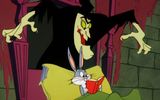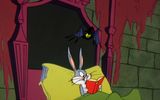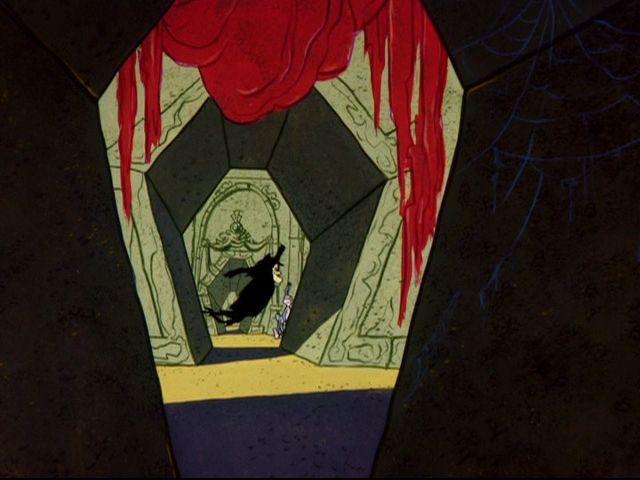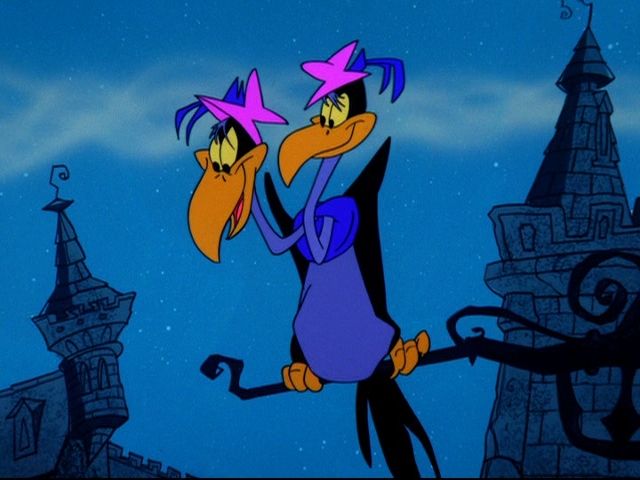SPOILERS

| Added | Sat, 21/08/2021 |
| Release date | 30-11-1963
|
| Original title | Transylvania 6-5000
|
| Феномены | |
| References |
"Transylvania 6-5000" is a short cartoon by Warner Bros. from the series "Merrie Melodies", released in 1963.
The title of the cartoon is a pun on the song "Pennsylvania 6-5000", performed by Glenn Miller. In turn, the name of the song refers to the now archaic numbering system of telephone exchanges, in which the first two characters of the number were expressed in letters. So, "Transylvania 6-5000" means "TR6-5000", which can be converted to the number 876-5000.
Despite the short duration of the cartoon, it seems to have served as a source of inspiration for the authors of the 1985 film of the same name.
Bugs Rabbit moves through the tunnels under the ground and bumps into a tree. He is heading to Pittsburgh, Pennsylvania, and does not immediately notice that a sign nailed to a tree reads: "Pittsburgh, Transylvania." He asks the way of the two-headed vulture (whose heads are called Agatha and Emily), but does not get an answer, because the vulture's heads are too busy talking about how to eat a rabbit.
Bugs leaves them, sees an old castle nearby, takes it for a hotel and calmly goes to it. Bugs, who rang the doorbell, is met by a vampire who introduces himself as Count Bloodcount, and invites him to enter. Bugs is just looking for a phone to call his travel agency, but the count takes him to the guest room, offering to rest, since "rest is good for the blood".
Unable to sleep, Bugs takes a book called "Magic Words and Phrases" from the shelf and, despite initial skepticism, begins to read it. The count sneaks up behind him and is about to attack, but at that moment Bugs says "abracadabra" and turns the count into a bat. Bugs mistakes the bat for a large mosquito and hits it with a fly swatter. When the bat flies out of the window, Bugs says "hocus pocus"; the count turns back into a vampire and falls into the moat surrounding his castle. Agatha and Emily discuss the fall of the Count.
Soon after, a hungry Bugs is looking for a restaurant. The count sneaks up from behind again, but Bugs hums the tune "t's Magic", replacing some words with" abracadabra", and accidentally turns the count into a bat. Once again mistaking the bat for a mosquito, Bugs sprays it with a fumigator.
Fed up with the ridiculous situation, the count reveals his true identity as a vampire, which leads to a duel of "magic phrases", as a result of which the count turns into a two-headed vulture. He flies to Agatha and Emily and soon finds himself the object of their romantic intentions. The count escapes from the castle, Agatha and Emily fly after him, and Bugs, satisfied with the results of his actions, watches them.
Finally, Bugs finds a working pay phone. While waiting for the operator to connect him to the travel agency, he sings "It's Magic" once again, this time replacing the words with "abraca-pocus". His ears immediately turn into bat wings. Bugs asks the operator to cancel the call, hangs up and decides to fly home on his new wings.
Phenomena in artwork: A vampire
The owner of the castle, Count Bloodcount, is a stereotypical hereditary vampire: he is dressed in a black cloak that looks like bat wings, hovers above the floor and lives in an old scary castle, on the walls of which are hung creepy portraits of his relatives (and some in the guise of a bat). The drawing style does not involve much detail, so you can only guess about the presence of fangs in the graph. Although we are not shown how he drinks blood, there is a certain fixation on this liquid: he often mentions it in his speech, and almost all the books on his shelves are devoted to blood and its varieties.
The count can cast spells, casting spells and turning into a bat.
Phenomena in artwork: Witchcraft
Both the owner of the castle and the main character of the cartoon bunny Bugs can cast spells by casting spells. There are two main spells: "abracadabra" and "hocus-pocus", and their effect depends on the context and the desires of the sorcerer. Derivatives of these spells ("abraka-pokus"," focus-kadabra", etc.) also produce a magical effect. It is not necessary to have abilities for witchcraft, it is enough to know spells.
With the help of spells, cartoon characters turn into both other creatures (bats or two-headed vultures) and inanimate objects (for example, a bat that hits the count on the head).
Phenomena in artwork: Flying creatures
In the cartoon there is a character representing a reasonable two-headed vulture. Each of his heads has its own consciousness and exchanges replicas with the other.
Two-headed vulture
Log in or register to post comments









